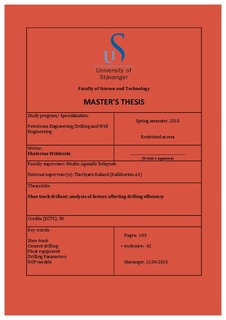| dc.description.abstract | Shoe track is a space between casing or liner shoe and the uppermost collar, which keeps contaminated cement after cementing operation has been performed. This term is also used to describe the whole downhole cementing configuration, which consists of wiper plugs, collar or collars, cement and a shoe. These components have to be drilled out to proceed with drilling of new formation. The process is often time-consuming and damaging for the drilling tools. At the same time shoe track drilling is a difficult operation to analyze due to big variety in float equipment design and materials used. Therefore, oil companies often rely on “best practices”, developed throughout years of experience.
This thesis presents analysis of shoe track drillouts data obtained from several wells, which are categorized into two major groups. The groups were chosen based on presence of common features, for example section size, bit and equipment used. All shoe track components were analyzed separately with respect to their design and drilling parameters used. Different shoe track components require customized drilling strategy. It was found, that design and number of wiper plugs, collars and float valves are certainly the major factors that affect drillout time of float equipment, which includes plugs, collars and shoe. Drilling parameters and materials used also play an important but secondary role during shoe track drillout. Variations in drill bits specifications, like number of cutters and nozzles, have minor influence on shoe track drillout efficiency.
Cement drilling greatly depends on operational parameters. As a part of the analysis, parameters used for drilling out cement in shoe track were considered and compared with the existing practice. Drilling optimization models have been used to determine drilling efficiency, carry out sensitivity analysis for drilling parameters and forecast penetration rate. Averaged drilling efficiency factor for cement was found using MSE concept. Penetration rate was modeled using Brourgoyne and Young method. Calculated penetration rate was then compared to logged feet-to-feet ROP values, and significant correlation was observed. Cement drillout study was completed with cuttings transport analysis, which was performed in WELLPLAN software to determine critical flow rate for successful drillout. | nb_NO |
